The Piezoelectric Materials Market is estimated to be valued at USD 4.5 billion in 2025 and is projected to reach USD 9.3 billion by 2035, registering a compound annual growth rate (CAGR) of 7.5% over the forecast period. During the first five years (2025–2030), the market is expected to rise from USD 4.5 billion to USD 6.5 billion, adding USD 2 billion, which accounts for 41.7% of total incremental growth, with a 5-year multiplier of 1.44x.
The second phase (2030–2035) contributes USD 2.8 billion, representing 58.3% of incremental growth, reflecting strong momentum as piezoelectric materials are increasingly integrated into high-performance applications such as robotics, renewable energy, and industrial automation. Annual increments grow from USD 0.4 billion in early years to USD 0.6 billion by 2035, signaling an acceleration in demand driven by emerging technologies and the need for more efficient, compact, and durable components. Manufacturers focusing on new piezoelectric materials with enhanced functionality and scalability will capture the largest share of this USD 4.8 billion opportunity.
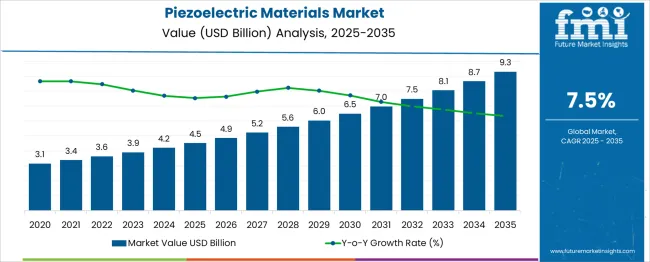
| Metric | Value |
|---|---|
| Piezoelectric Materials Market Estimated Value in (2025 E) | USD 4.5 billion |
| Piezoelectric Materials Market Forecast Value in (2035 F) | USD 9.3 billion |
| Forecast CAGR (2025 to 2035) | 7.5% |
The Piezoelectric Materials market is progressing steadily, driven by advancements in microelectromechanical systems, rising demand for precision sensors, and the integration of smart materials across industrial automation and consumer electronics. These materials have been increasingly adopted in a range of applications due to their ability to convert mechanical stress into electrical signals and vice versa.
The market’s expansion has been further supported by innovations in additive manufacturing and the development of environmentally friendly lead-free alternatives. Government initiatives promoting energy-efficient technologies, as well as the rising emphasis on real-time data acquisition in sectors such as automotive, healthcare, and aerospace, have also contributed to market momentum.
As industries continue to digitalize and prioritize performance, piezoelectric materials are expected to play a critical role in enhancing the functionality of sensing, actuation, and energy harvesting systems. With research institutions and commercial enterprises investing in material science innovation, the market is poised for long-term growth and technological refinement..
The piezoelectric materials market is segmented by material type, form, application, end-use industry, and geographic regions. The piezoelectric materials market is divided into Piezoelectric ceramics, Piezoelectric polymers, Piezoelectric composites, Piezoelectric single crystals, and Other piezoelectric materials. In terms of forms, the piezoelectric materials market is classified into Bulk materials, Thin films, Nanostructures, Multilayer structures, and Others. Based on the application, the piezoelectric materials market is segmented into Sensors, Actuators, Transducers, Generators, Motors, and Others.
The end-use industry of the piezoelectric materials market is segmented into Consumer electronics, Healthcare, Automotive, Industrial, Aerospace & defense, Energy harvesting, and Others. Regionally, the piezoelectric materials industry is classified into North America, Latin America, Western Europe, Eastern Europe, Balkan & Baltic Countries, Russia & Belarus, Central Asia, East Asia, South Asia & Pacific, and the Middle East & Africa.
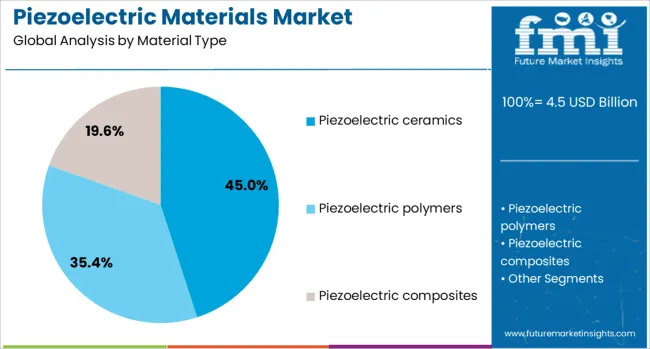
The piezoelectric ceramics segment is projected to account for 45% of the Piezoelectric Materials market revenue share in 2025, making it the leading material type. This dominance has been attributed to the high electromechanical coupling efficiency and mechanical strength offered by ceramic-based materials, which enable precise control in critical applications.
These materials have been widely used in ultrasonic transducers, actuators, and vibration dampers due to their stable performance under a wide range of frequencies and temperatures. Their cost-effectiveness, coupled with their compatibility with miniaturized device architectures, has also facilitated widespread adoption across automotive, medical, and consumer electronics sectors.
Manufacturing scalability and mature processing technologies have further solidified the role of piezoelectric ceramics in both legacy systems and emerging platforms. As the demand for real-time response systems grows across multiple industries, the reliability and tunability of ceramic-based materials have positioned this segment as a core contributor to market growth..
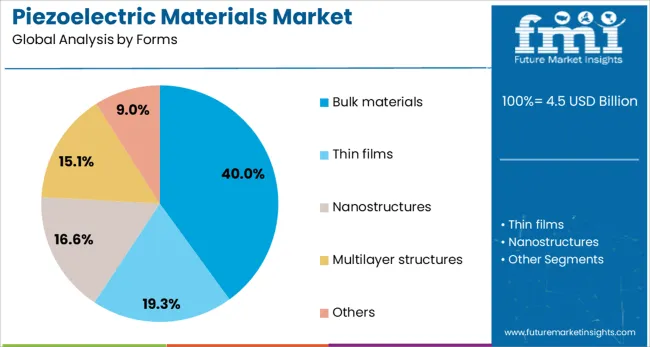
The bulk materials segment is estimated to hold 40% of the Piezoelectric Materials market revenue share in 2025, establishing it as the dominant form in the industry. This segment's growth has been driven by the need for robust mechanical integrity and consistent piezoelectric response in high-power applications.
Bulk forms have been favored in heavy-duty sensing and actuation systems where surface area and volume significantly influence performance metrics. Their ability to maintain structural and electrical stability under repeated stress has made them the preferred choice in industrial automation, aerospace components, and ultrasonic cleaning systems.
The straightforward fabrication and assembly processes associated with bulk materials have also supported their inclusion in a wide array of manufacturing environments. As precision-driven and high-load applications expand across key sectors, bulk materials have continued to meet the rigorous performance demands, thereby reinforcing their market leadership within the broader forms category..
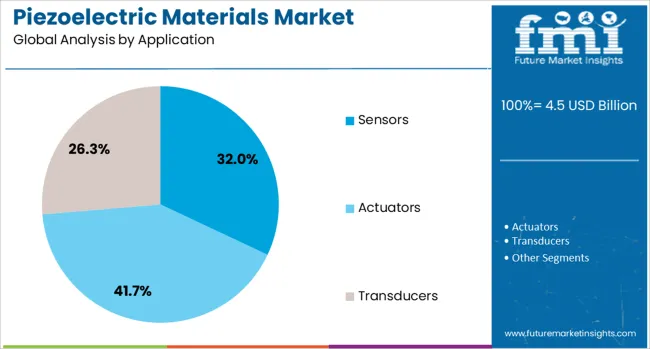
The sensors segment is projected to capture 32% of the Piezoelectric Materials market revenue share in 2025, marking it as the leading application area. The dominance of this segment has been supported by the growing need for accurate, real-time monitoring systems across industries such as healthcare, automotive, and industrial automation. Piezoelectric materials have been particularly valued in sensor applications for their high sensitivity, rapid response time, and ability to operate without external power sources.
These properties have enabled the development of compact and efficient sensing solutions for pressure, vibration, and acceleration measurements. The continued advancement in Internet of Things infrastructure and smart manufacturing has further driven the demand for piezoelectric sensors in distributed systems.
Additionally, the integration of these sensors into wearable health devices and structural monitoring systems has created new avenues for growth. The reliability and precision offered by piezoelectric-based sensors have ensured their sustained adoption in both legacy and forward-looking technologies..
The piezoelectric materials market is expanding due to the growing demand for efficient components in electronics, automotive, and healthcare sectors. Opportunities in these industries, particularly in sensors and energy harvesting applications, are driving growth. Trends toward flexible, multi-functional materials are reshaping the market, while challenges related to high production costs and material availability remain significant. By 2025, overcoming these challenges through innovation in manufacturing will be crucial for maintaining market momentum.
The piezoelectric materials market is growing due to the increasing demand for efficient components in electronics. These materials are used in sensors, actuators, and energy harvesting devices, driving growth across industries such as automotive, consumer electronics, and healthcare. The rise in wearable devices, IoT, and industrial automation is contributing to the growing need for piezoelectric components. By 2025, demand for these materials is expected to continue growing as electronic devices become smaller and more efficient.
Opportunities in the piezoelectric materials market are expanding in the automotive and healthcare sectors. In automotive applications, piezoelectric materials are used in sensors for safety systems, as well as in energy harvesting systems. The healthcare sector is adopting these materials for advanced medical devices, such as ultrasonic imaging equipment. By 2025, these sectors will significantly contribute to market growth, with new applications and rising demand for precise, efficient materials.
Emerging trends in the piezoelectric materials market show a shift towards flexible and multi-functional materials. As demand for lightweight, bendable, and more versatile components rises, piezoelectric materials are evolving to meet these needs. The growing trend in wearable devices and flexible electronics is fueling this change, with innovations focusing on improving the functionality and durability of these materials. By 2025, the market will likely see an increase in the use of flexible piezoelectric materials in consumer and industrial applications.
Despite the market’s growth, challenges related to high production costs and limited raw materials persist. The synthesis of high-performance piezoelectric materials requires complex processes and rare materials, contributing to higher production costs. Additionally, fluctuations in the availability of key raw materials, such as lead or certain ceramics, can disrupt the supply chain. These factors may limit the widespread adoption of piezoelectric materials, particularly in cost-sensitive applications, unless more efficient production methods are developed by 2025.
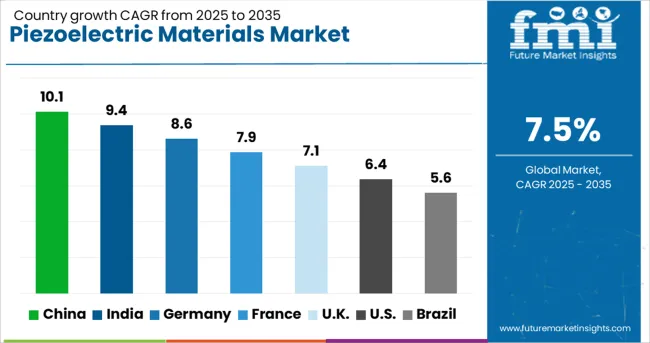
| Country | CAGR |
|---|---|
| China | 10.1% |
| India | 9.4% |
| Germany | 8.6% |
| France | 7.9% |
| UK | 7.1% |
| USA | 6.4% |
| Brazil | 5.6% |
The global piezoelectric materials market is projected to grow at a 7.5% CAGR from 2025 to 2035. China leads with a growth rate of 10.1%, followed by India at 9.4%, and Germany at 8.6%. The United Kingdom records a growth rate of 7.1%, while the United States shows the slowest growth at 6.4%. These differences in growth rates are influenced by factors such as increasing demand for sensors, actuators, and advanced materials in automotive, electronics, and industrial applications. Emerging markets like China and India are experiencing higher growth due to rapid industrialization, technological advancements, and rising demand for piezoelectric devices, while more mature markets like the USA and the UK show steady growth driven by established industries and increasing adoption of smart technologies. This report includes insights on 40+ countries; the top markets are shown here for reference.
The piezoelectric materials market in China is growing at an impressive pace, with a projected CAGR of 10.1%. As China continues to expand its manufacturing and electronics sectors, the demand for piezoelectric materials, used in sensors, actuators, and energy harvesting devices, is increasing rapidly. The country’s focus on advancing smart technologies, including IoT, robotics, and automotive applications, further accelerates the adoption of piezoelectric materials. Additionally, China’s strong investments in renewable energy and environmental monitoring systems are driving the demand for piezoelectric devices in energy harvesting and sensor applications, supporting robust market growth.
The piezoelectric materials market in India is projected to grow at a CAGR of 9.4%. India’s growing demand for piezoelectric materials in industrial applications, healthcare devices, and consumer electronics is contributing significantly to market growth. The rise in smart infrastructure, automotive innovation, and the adoption of piezoelectric materials in industrial sensors and actuators are further boosting the market. Additionally, government initiatives promoting technological innovation in manufacturing, along with the increasing focus on energy efficiency, are expected to fuel the demand for piezoelectric materials, making India a key growth market in the Asia-Pacific region.
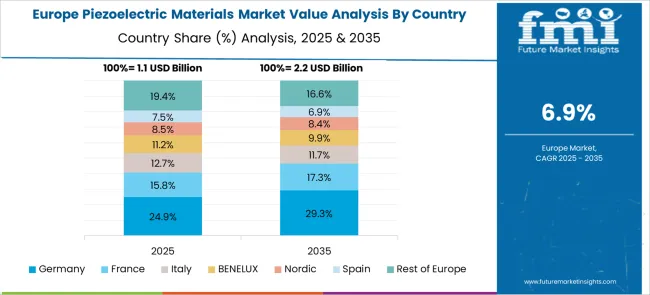
The piezoelectric materials market in Germany is projected to grow at a CAGR of 8.6%. Germany’s well-established manufacturing and automotive industries, combined with its strong focus on advanced technologies, are driving demand for piezoelectric materials. The increasing use of piezoelectric sensors, actuators, and energy harvesting devices in automotive systems, industrial automation, and robotics is further contributing to market growth. Additionally, Germany’s strong commitment to sustainability and renewable energy sources boosts the need for piezoelectric materials in energy harvesting applications. The country’s investments in smart manufacturing technologies and automation ensure continued growth in the piezoelectric materials market.
The piezoelectric materials market in the United Kingdom is projected to grow at a CAGR of 7.1%. The UK continues to focus on developing advanced sensor technologies for industrial applications, which drives demand for piezoelectric materials. With growing investments in the automotive sector and a rising adoption of IoT devices, piezoelectric materials are becoming increasingly important in the production of sensors and actuators. The UK government’s focus on sustainability and the integration of smart technologies across industries also supports the market. However, the growth is relatively slower compared to emerging economies, due to a more mature market and established infrastructure.
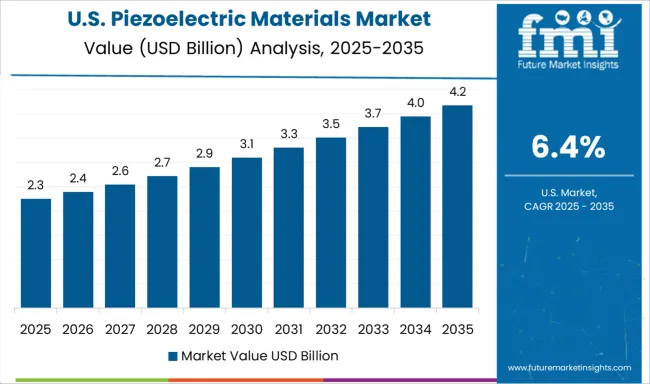
The piezoelectric materials market in the United States is expected to grow at a CAGR of 6.4%. Despite being a mature market, the USA continues to see steady demand for piezoelectric materials driven by the automotive, electronics, and healthcare industries. The increasing use of piezoelectric sensors and actuators in applications such as robotics, medical devices, and smart systems contributes to market growth. Additionally, the USA government’s emphasis on advancing manufacturing technologies, coupled with ongoing investments in energy-efficient solutions, further supports the demand for piezoelectric materials. However, growth in the USA is slower compared to emerging markets due to market maturity.

The piezoelectric materials market is dominated by KYOCERA Corporation, which leads with its extensive portfolio of high-performance piezoelectric materials used in various applications such as sensors, actuators, and medical devices. KYOCERA’s dominance is supported by its strong R&D capabilities, advanced manufacturing processes, and global presence in the electronics, automotive, and healthcare industries. Key players such as PI Ceramic GmbH, CTS Corporation, and Morgan Advanced Materials maintain significant market shares by providing specialized piezoelectric materials that offer high sensitivity, reliability, and durability in demanding applications. These companies focus on delivering innovative solutions for vibration sensing, precision actuators, and energy harvesting devices.
Emerging players like APC International Ltd., Sparkler Ceramics Pvt. Ltd., and TDK Corporation are expanding their market presence by offering cost-effective and customized piezoelectric materials for niche markets such as industrial equipment, consumer electronics, and automotive applications. Their strategies include enhancing material properties, improving energy conversion efficiency, and targeting regional markets with tailored products. Market growth is driven by the increasing demand for smart devices, industrial automation, and wearable technology. Innovations in lead-free piezoelectric materials, flexible piezoelectric components, and advancements in material synthesis are expected to continue shaping competitive dynamics and fuel further growth in the global piezoelectric materials market.
| Item | Value |
|---|---|
| Quantitative Units | USD 4.5 Billion |
| Material Type | Piezoelectric ceramics, Piezoelectric polymers, Piezoelectric composites, Piezoelectric single crystals, and Other piezoelectric materials |
| Forms | Bulk materials, Thin films, Nanostructures, Multilayer structures, and Others |
| Application | Sensors, Actuators, Transducers, Generators, Motors, and Others |
| End-Use Industry | Consumer electronics, Healthcare, Automotive, Industrial, Aerospace & defense, Energy harvesting, and Others |
| Regions Covered | North America, Europe, Asia-Pacific, Latin America, Middle East & Africa |
| Country Covered | United States, Canada, Germany, France, United Kingdom, China, Japan, India, Brazil, South Africa |
| Key Companies Profiled | KYOCERA Corporation, APC International Ltd., PI Ceramic GmbH, CTS Corporation, Morgan Advanced Materials, Sparkler Ceramics Pvt. Ltd., and TDK Corporation |
| Additional Attributes | Dollar sales by material type and application, demand dynamics across automotive, electronics, and healthcare sectors, regional trends in piezoelectric material adoption, innovation in sensor technologies and energy harvesting, impact of regulatory standards on performance and safety, and emerging use cases in IoT devices, robotics, and renewable energy systems. |
The global piezoelectric materials market is estimated to be valued at USD 4.5 billion in 2025.
The market size for the piezoelectric materials market is projected to reach USD 9.3 billion by 2035.
The piezoelectric materials market is expected to grow at a 7.5% CAGR between 2025 and 2035.
The key product types in piezoelectric materials market are piezoelectric ceramics, _lead zirconate titanate (pzt), _barium titanate (batio₃), _sodium potassium niobate (knn), _sodium bismuth titanate (nbt), _other piezoelectric ceramics, piezoelectric polymers, _polyvinylidene fluoride (pvdf), _pvdf copolymers, _other piezoelectric polymers, piezoelectric composites, _ceramic-polymer composites, _ceramic-ceramic composites, _other piezoelectric composites, piezoelectric single crystals, _quartz, _relaxor-pt single crystals, _other piezoelectric single crystals and other piezoelectric materials.
In terms of forms, bulk materials segment to command 40.0% share in the piezoelectric materials market in 2025.






Full Research Suite comprises of:
Market outlook & trends analysis
Interviews & case studies
Strategic recommendations
Vendor profiles & capabilities analysis
5-year forecasts
8 regions and 60+ country-level data splits
Market segment data splits
12 months of continuous data updates
DELIVERED AS:
PDF EXCEL ONLINE
Piezoelectric Devices Market Size and Share Forecast Outlook 2025 to 2035
Piezoelectric Sensors Market Analysis - Size, Share, & Forecast Outlook 2025 to 2035
Piezoelectric Polymers Market Size and Share Forecast Outlook 2025 to 2035
Piezoelectric Accelerometer Market Size and Share Forecast Outlook 2025 to 2035
Piezoelectric Ceramics Market Analysis by Type, Application and Region: Forecast for 2025 to 2035
Breaking Down Market Share in Piezoelectric Sensors Manufacturing
Dental Piezoelectric Ultrasonic Unit Market Trends and Forecast 2025 to 2035
Automotive Piezoelectric Fuel Injectors Market Size and Share Forecast Outlook 2025 to 2035
BNT Lead-free Piezoelectric Ceramics Market Size and Share Forecast Outlook 2025 to 2035
Nanomaterials Market Insights - Size, Share & Industry Growth 2025 to 2035
Tire Materials Market Insights – Size, Trends & Forecast 2025–2035
Facade Materials Market Size and Share Forecast Outlook 2025 to 2035
Solder Materials Market Size and Share Forecast Outlook 2025 to 2035
Sheath Materials Market Size and Share Forecast Outlook 2025 to 2035
Exosuit Materials Market Size and Share Forecast Outlook 2025 to 2035
Stealth Materials and Coatings Market Size and Share Forecast Outlook 2025 to 2035
Battery Materials Recycling Market Size and Share Forecast Outlook 2025 to 2035
Battery Materials Market: Growth, Trends, and Future Opportunities
Optical Materials Market - Trends & Forecast 2025 to 2035
Circuit Materials Market Analysis based on Substrate, Conducting Material, Outer Layer, Application, and Region: Forecast for 2025 and 2035

Thank you!
You will receive an email from our Business Development Manager. Please be sure to check your SPAM/JUNK folder too.
Chat With
MaRIA